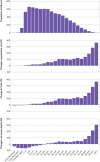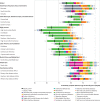Global, regional, and national burden of diseases and injuries for adults 70 years and older: systematic analysis for the Global Burden of Disease 2019 Study
- PMID: 35273014
- PMCID: PMC9316948
- DOI: 10.1136/bmj-2021-068208
Global, regional, and national burden of diseases and injuries for adults 70 years and older: systematic analysis for the Global Burden of Disease 2019 Study
Abstract
Objectives: To use data from the Global Burden of Diseases, Injuries, and Risk Factors Study 2019 (GBD 2019) to estimate mortality and disability trends for the population aged ≥70 and evaluate patterns in causes of death, disability, and risk factors.
Design: Systematic analysis.
Setting: Participants were aged ≥70 from 204 countries and territories, 1990-2019.
Main outcomes measures: Years of life lost, years lived with disability, disability adjusted life years, life expectancy at age 70 (LE-70), healthy life expectancy at age 70 (HALE-70), proportion of years in ill health at age 70 (PYIH-70), risk factors, and data coverage index were estimated based on standardised GBD methods.
Results: Globally the population of older adults has increased since 1990 and all cause death rates have decreased for men and women. However, mortality rates due to falls increased between 1990 and 2019. The probability of death among people aged 70-90 decreased, mainly because of reductions in non-communicable diseases. Globally disability burden was largely driven by functional decline, vision and hearing loss, and symptoms of pain. LE-70 and HALE-70 showed continuous increases since 1990 globally, with certain regional disparities. Globally higher LE-70 resulted in higher HALE-70 and slightly increased PYIH-70. Sociodemographic and healthcare access and quality indices were positively correlated with HALE-70 and LE-70. For high exposure risk factors, data coverage was moderate, while limited data were available for various dietary, environmental or occupational, and metabolic risks.
Conclusions: Life expectancy at age 70 has continued to rise globally, mostly because of decreases in chronic diseases. Adults aged ≥70 living in high income countries and regions with better healthcare access and quality were found to experience the highest life expectancy and healthy life expectancy. Disability burden, however, remained constant, suggesting the need to enhance public health and intervention programmes to improve wellbeing among older adults.
© Author(s) (or their employer(s)) 2019. Re-use permitted under CC BY. No commercial re-use. See rights and permissions. Published by BMJ.
Conflict of interest statement
Competing interests: All authors have completed the ICMJE uniform disclosure form at www.icmje.org/disclosure-of-interest/ and declare support from CHTF, the Bill and Melinda Gates Foundation, IPEP, Instituto de Salud Carlos III—Spain, and FEDER for the submitted work; no financial relationships with any organisations that might have an interest in the submitted work in the previous three years; no other relationships or activities that could appear to have influenced the submitted work.
Figures







References
-
- Development in an Ageing World. World Economic and Social Survey 2007. https://www.un.org/en/development/desa/policy/wess/wess_archive/2007wess... (accessed 27 Jan 2018).
-
- European Commission. Population ageing in Europe: facts, implications and policies 2014. https://op.europa.eu/en/publication-detail/-/publication/1e7549b4-2333-4....
Publication types
MeSH terms
Grants and funding
LinkOut - more resources
Full Text Sources
Medical
